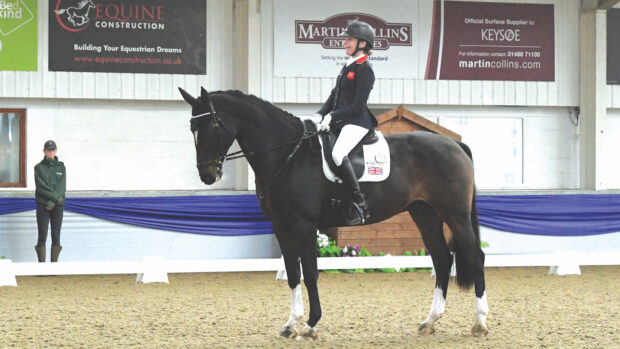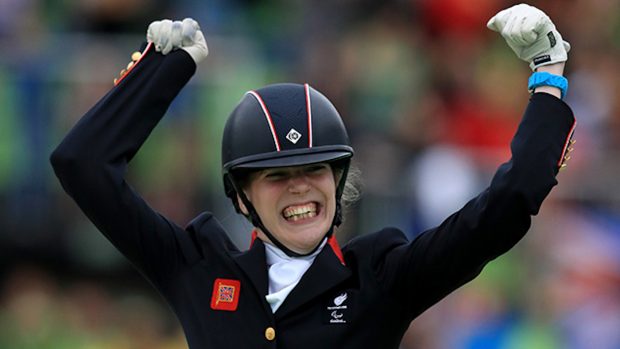A rider has been denied the right to compete in para dressage despite the fact she can “barely breathe”.
Gloucestershire-based Bex Greenwood has had 18 operations and a tracheostomy since she was diagnosed with cancer in her neck in 2016.
The former eventer has returned to the saddle but her tracheostomy severely affects her riding.
“I have gone from having two nostrils and a mouth to breathe through to a tube the size of a drinking straw,” she told H&H.
“You can’t regulate the air and the tube collects dust and dirt so can be hard if it is very dry.

Bex during her eventing days
“In cold weather that goes straight to your lungs and it feels like having ‘brain freeze’ on your chest.”
Mrs Greenwood can only ride for a maximum of 15 minutes before she needs to rest, and she frequently needs to stop to clean her breathing tube, which becomes blocked with mucus and dust.
“Most people [with a tracheostomy] struggle to walk up and down the street, let alone try to ride,” she added.
Mrs Greenwood planned to compete in para dressage but has been told by the British Equestrian Federation (BEF) she is not eligible, as her disability does not restrict her movement.
Her trainer, top dressage rider and H&H columnist Pammy Hutton, believes tracheotomies should be incorporated into para classifications.
“I often find that clarification doesn’t take their physical limits into account,” she said. “Bex can barely breathe.”

Bex during her eventing days
#breatheforbex
Since she was given the news, her friends have taken up the #breatheforbex challenge, to raise awareness of her condition.
They have filmed themselves riding while breathing through a straw to experience what it is like to have a tracheostomy.
“I thought they might come back to me and say it was really easy but that wasn’t the case,” added Mrs Greenwood.
A BREATH OF FRESH AIRI’m sure you will have all read pammy Huttons column in the horse and hound about trac patients and how having cancer and with this trac is not recognised for being registered as a para. Please view the video and let’s raise awareness for a very special lady Bex Greenwood who although being struck down by this still continues to push herself and enjoy her life and horses. I ask and invite friends on behalf of Bex Greenwood with a challenge to close off there nose and breathe through a small drinking straw while riding, film it and post it on fb with #breatheforbexPlease tag her in your posts as she would love to see them. Maybe a small comment on how you found it. If it effected your performance at all. ? often this drinking straw will be filled with mucus from your lungs alongside side with a lung plug or two. See photos.Tracheostomy patients deal with this everyday -don’t even get me started on the minus weather or dust. With a trach you also can not control the speed in which your air comes in or out Just a interesting thought, will you take the challenge ? #breatheforbexPlease share ?
Posted by Laura Watts on Sunday, April 15, 2018
British Dressage (BD) chief executive Jason Brautigam told H&H breathing conditions are not classifiable under the current system.
“This is determined by the FEI and BEF, rather than BD, but we all adhere to the same guidelines,” he said.“Without such classification this particular rider would not be able to compete in BD para competitions; she would still of course be permitted to ride in able-bodied classes.
“We do have other riders with breathing conditions who have been granted dispensation for aids that enable them to compete and we are always happy to review individual requests on a case by case basis.”
A spokesman for the FEI said athletes applying for classification must have a health condition that “leads to a permanent and measurable impairment”, and which meets the criteria described in the 2018 FEI classification rules.
Continued below…

A horse on the roof? You’re not hallucinating, we promise
Pinch yourself: this yard is for real. Set in the ‘Pampas’ region of Argentina, this futuristic set-up is the home

A muddy disaster! What can I do to help my grass grow this spring? H&H asks an expert
What can you do to optimize grass growth this spring?

11 situations which only make sense to us horsey nuts #horselogic
“The rules state the nine eligible impairments for para equestrian and while it is recognised many other impairments exist, these nine impairments align with the Paralympic movement eligible impairments,” she told H&H.
“It is recognised that living with a tracheostomy would raise many challenges for an individual and the FEI does not diminish the impact of such a condition.
“That said, there are many health conditions that do not lead to an eligible impairment for para equestrian.”
For all the latest news analysis, competition reports, interviews, features and much more, don’t miss Horse & Hound magazine, on sale every Thursday.
In this week’s magazine, out on Thursday 19 April 2018, don’t miss our special report from the British Dressage Winter Championships, plus full analysis from the Grand National — including expert comment, pictures and more. Read our report from the dressage and showjumping World Cup finals, and in this week’s ‘vet clinic’ we discuss the facts about fitness.




